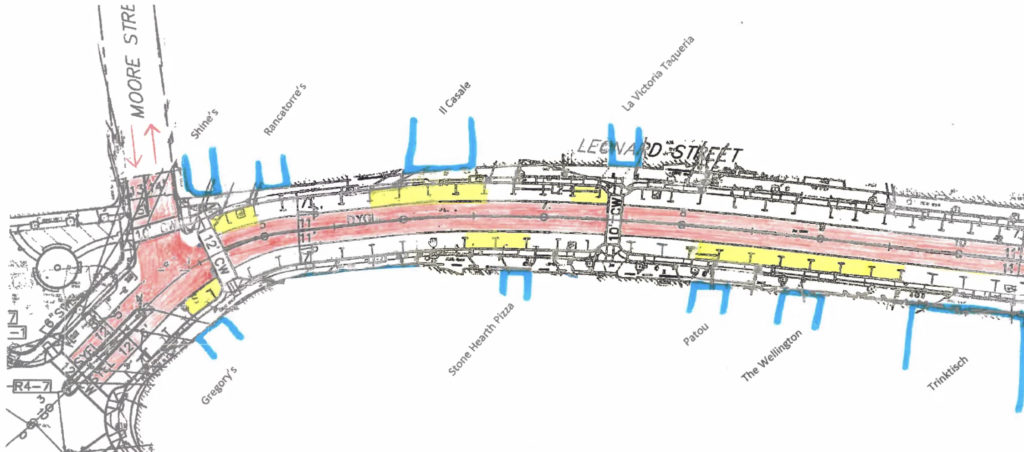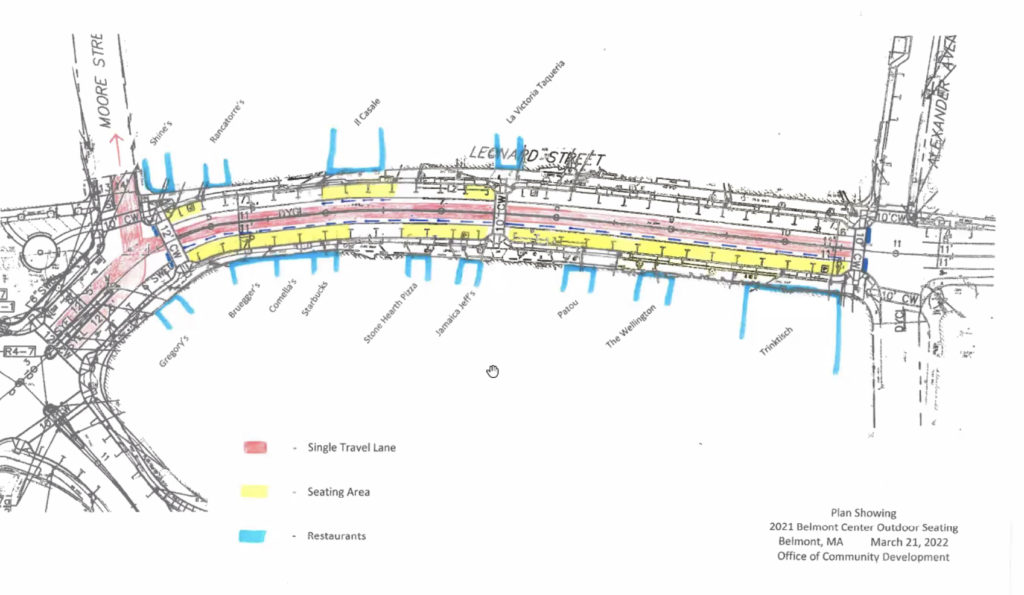Photo: The end of the pedestrian-friendly summer plan
The two-year experiment known for calming traffic and prompting walking and al fesco dining in Belmont’s business center has come to an end.
The Belmont Select Board voted, 2-1, Monday, March 21 to end pedestrian-friendly summers along Leonard Street in Belmont Center as the board’s majority approved a blueprint created by the Belmont Center Business Association that emphasizes auto traffic and long stretches of parking.
The approved plan essentially maintains the center’s current traffic pattern with it’s two-lanes of commuter traffic running through the town’s main hub.
“In terms of traffic flows … nothing would be any different than it is today because it would be retain two-way travel,” said Glen Clancy, Belmont’s director of Community Development.
The one exception to the current design will be jersey barrier-protected bump outs in front of selected restaurants and eateries to allow for a small outdoor dining area. The number of restaurants seeking seating will decrease from 14 to 9, much due to changing business environment. Owner of The Toy Shop of Belmont, Daren Muckjian, told the board that a reduction of Center eateries including Starbucks and Comella’s just didn’t warrant the amount of spaces taken out of circulation.
“I hate to have barriers and spaces in front of empty spaces. What’s the purpose and what’s the reason behind it?” he said.
There will also be “a significant number of parking spaces gained” said Clancy, including converting the former MBTA bus stop adjacent to the town “delta” adjacent to the People’s United Bank branch from a loading zone into additional spaces. Where once the near entirety of the parking spaces on the east-side of Leonard Street was converted to seating, this year most will revert back to the curb parking.
The metal railings that ran the length of Leonard Street which provided a safety barrier between autos and the walking public will not longer be part of the scheme as the business association referred to them as a “maintenance headache,” said Clancy. In addition, cyclists will be asked to share the traffic lanes with vehicle traffic as the jersey barriers will take up that space.

Devised by the town and Select Board in the spring of 2020 to allow the center’s eateries room to create outdoor dining when the Covid-19 pandemic closed indoor service at restaurants, the opening of Leonard Street with a single traffic lane from Alexander Avenue to Channing Road created a pedestrian-friendly area that attracted strollers, shoppers and diners to the business district. In 2021, additional parking was created along the street as well as flower pots and new railing as the length of the closure was increased from early May to late October.
Despite being popular with residents and shoppers, a segment of the business association’s membership has opposed to the one-way, pedestrian version since its inception, claiming their operations suffered financially due to the lack of direct on-street parking and commerce generated by the mostly out-of-town commuter trade. While there is a large municipal parking lot in the rear of the center along Claflin Street, the merchants said it is too far for many shoppers.
Another reason for the businesses opposition this summer is cost as the local family which donated the funds to install the jersey barriers will not commit that money in 2022, according to Muckjian.
For the Select Board’s majority, the business association’s option appeared to meet the needs of those most impacted by the road changes.
“I think we’re feeling our way … to striking a balance between different businesses that may have different priorities,” said the Select Board’s Roy Epstein, as restaurants keep their outside dining areas – albeit diminished in square footage – while retailers have their on-street parking.
With the town-wide mask mandate lifted for businesses and indoor dining expected to “flourish, I think this is a fine compromise,” said the Select Board’s Mark Paolillo, who said businesses have “suffered” due to the lack of on-street parking in front of their establishments.
But Dash said that since last year, “I’m concerned that we keep eroding this plan” noting the original concept in 2020 advocated doing away with vehicles in the center as many European municipalities and some US resort areas have done.
“Now we are talking about two-way traffic. At some point [you have to ask]’what’s the point?’” said Dash. “I’ve heard from residents that either do what you did last year or get rid of the cars altogether. I’ve heard zero people in the public say ‘I want two-way traffic’,” he said.
“I’ve also talked to businesses in the Center who wanted the same that it was last year,” said Dash.
But Epstein countered Dash view by noting the plan has changed yearly due to new conditions.
“I don’t believe we are eroding the concept, I think we are evolving the concept because we’re trying to balance a number of different constituencies,” including a number of merchants who believe “keeping two-way traffic year-round is a matter of life or death” for their businesses.
He suggested creating a lower speed limit targeting Leonard Street as a way to make the area “a little more acceptable.”
“It would be better if we had the one-way travel lane and a dedicated bike lane,” said Dash, who was the lone dissenting vote. “At least the commuters will love it.”









Leave a Review or Comment